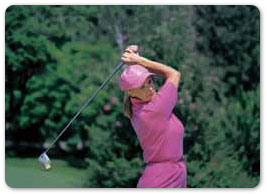
You may have heard of tennis elbow, but golfer’s elbow is a less common problem that can affect not only golfers whose swings have imperfections but anyone who performs intensely repetitive tasks requiring wrist flexion, such as painting walls, hammering, typing on a keyboard or even cooking. It may also result from improper form during sports motions unrelated to golf, including throwing a ball, lifting weights and even swinging a tennis racket.
Golfer’s elbow is the common term for medial epicondylitis—the inflammation or other damage to the common flexor tendon on the large “bump” located on the inside of your elbow. Tennis elbow, conversely, is lateral epicondylitis, in which the outer elbow tendons are involved. Because the common flexor tendon is connected to the wrist flexor muscles, improper and/or repetitive use of the wrist causes medial epicondylitis.
A tendon is composed of collagen. In some cases of golfer’s elbow, the collagen of the common flexor tendon becomes inflamed; in others, the collagen has undergone so much “wear and tear” that degeneration and scar tissue have resulted.
We can create an individualized treatment plan to help you deal with the pain in your elbow. These management strategies may include simple changes such as resting the elbow, taking over-the-counter pain relievers (as recommended by your physician) and icing the affected area several times daily. In addition, we may recommend very specific stretching and strengthening exercises, as well as electrical stimulation. We will work with you as you learn to keep your wrist as rigid as possible during whatever activity caused the initial problem and other motions involving the wrist. An elastic bandage or tape around your elbow or a forearm strap may also help.
Infrequently, severe cases of golfer’s elbow require surgery. In those situations, we can create a detailed recovery plan that begins with splinting immediately after the repair and progresses through pain and swelling management, massage, stretching and strengthening, and, finally, exercises to restore your range of motion.
Fortunately, golfer’s elbow is treatable and does not have to become a source of chronic pain. With the right plan of action, you can soon feel up to par again and return to your sport even stronger than before.
















